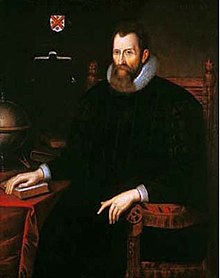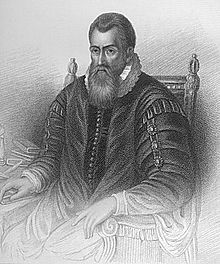John Napier: Difference between revisions
No edit summary |
Undid revision 267287650 by 76.95.160.128 (talk) |
||
| Line 1: | Line 1: | ||
{{Infobox Scientist |
{{Infobox Scientist |
||
|name = John |
|name = John Napier |
||
|box_width = 300px |
|box_width = 300px |
||
|image = John_Napier.jpg |
|image = John_Napier.jpg |
||
| Line 6: | Line 6: | ||
|caption = John Napier (1550-1617) |
|caption = John Napier (1550-1617) |
||
|birth_date = 1550 |
|birth_date = 1550 |
||
|birth_place = [[Merchiston Castle| |
|birth_place = [[Merchiston Castle|Merchiston Tower]], [[Edinburgh]], [[Kingdom of Scotland|Scotland]] |
||
|death_date = [[4 April]], [[1617]] |
|death_date = [[4 April]], [[1617]] |
||
|death_place = [[Edinburgh]], [[Scotland]] |
|death_place = [[Edinburgh]], [[Scotland]] |
||
Revision as of 14:04, 30 January 2009
John Napier | |
|---|---|
 John Napier (1550-1617) | |
| Born | 1550 |
| Died | 4 April, 1617 |
| Nationality | Scottish |
| Alma mater | St Andrews University |
| Known for | Logarithms Napier's bones Decimal notation |
| Scientific career | |
| Fields | Mathematician |
- For other people with the same name, see John Napier (disambiguation).
John Napier of Merchistoun (1550 – 4 April 1617) - also signed as Neper, Nepair - named Marvellous Merchiston, was a Scottish mathematician, physicist, astronomer/astrologer and 8th Laird of Merchistoun, son of Sir Archibald Napier of Merchiston. He is most remembered as the inventor of logarithms and Napier's bones, and for popularizing the use of the decimal point. Napier's birth place, Merchiston Tower, Edinburgh, Scotland, is now part of Napier University. After dying of gout, Napier was buried in St Cuthbert's Church, Edinburgh.
Advances in mathematics
Napier is best known inside mathematical and engineering circles, where he made what is undoubtedly a key advance in the use of mathematics. Logarithms are the converse of powered numbers, and made calculations by hand much easier and quicker, and thereby opened the way to many later scientific advances. His work, Mirifici Logarithmorum Canonis Descriptio, contained fifty-seven pages of explanatory matter and ninety pages of tables, which facilitated advances in astronomy, dynamics, physics, and astrology. He also improved Simon Stevin's decimal notation, and Arab lattice multiplication, used by Fibonacci, writing Napier's bones, a multiplication tool using a set of numbered rods.
Napier used some of his mathematical talents for theology, as he used the Book of Revelation to predict the Apocalypse, in A Plaine Discovery of the Whole Revelation of St. John, which he regarded as his most important work. Napier believed that the end of the world would occur in 1688 or 1700. He is also sometimes claimed to have been a necromancer; however, it was common for scientifically talented people of the period to be accused of such things without basis.

In addition to his mathematical and religious interests, Napier was commonly believed to be a magician, and is thought to have dabbled in alchemy and necromancy. It was said that he would travel about with a black spider in a small box, and that his black rooster was his familiar spirit.[1][2]
Napier used this rooster to find out which of his servants had been stealing from his home. He would shut the suspects one at a time in a room with the bird, telling them to stroke it. The rooster would then tell Napier which of them was guilty. Actually, what would happen is that he would secretly coat the rooster with soot. Servants who were innocent would have no qualms about stroking it but the guilty one would only pretend he had, and when Napier examined their hands, the one with the clean hands was guilty.[3]
Another occasion which may have contributed to his reputation as a sorcerer involved a neighbour whose pigeons were found to be eating Napier's grain. Napier warned him that from now on he intended to keep any pigeons found on his property. The next day, it is said, Napier was witnessed surrounded by unusually passive pigeons which he was scooping up and putting in a sack. The previous night he had soaked some peas in brandy, and then sown them. Come morning, the pigeons had gobbled them up, rendering themselves incapable of flight.[4]
Also of note is that a contract still exists between John Napier and one Robert Logan of Restalrig to search Fast Castle (by means of magic) for treasure allegedly hidden there, and wherein it is stated that Napier should
"...do his utmost diligence to search and seek out, and by all craft and ingine to find out the same, or make it sure that no such thing has been there."[5]
Eponyms
An alternative unit to the decibel used in electrical engineering, the neper, is named after John Napier, as is Napier University in Edinburgh.
The crater Neper on the Moon is named after him,[1] as is asteroid 7096 Napier.
List of works
- (1593) A Plaine Discovery of the Whole Revelation of St. John.
- (1614) Mirifici logarithmorum canonis descriptio (a translation into English by Edward Wright was published in 1616).
- (1617) Rhabdologia (published posthumously).
- (1619) Mirifici logarithmorum canonis constructio (written before the 'Descriptio', but published posthumously by his son Robert)
See also
Notes
- ^ http://news.scotsman.com/scitech.cfm?id=523542005 Scotsman article about John Napier
- ^ http://heritage.scotsman.com/myths.cfm?id=41962005 Scotsman article specifically about Napier's interest in the occult
- ^ http://www.johnnapier.com/john_napier_and_the_devil.htm John Napier and the Devil
- ^ http://www.twinfield.net/teachers/buret/documents/biographies/Napier.pdf A Biography of John Napier
- ^ http://www.siol-nan-gaidheal.com/manuscripts/3/LXXV-3.htm Scans of the original charter and a later typed translation
References
- O'Connor, John J.; Robertson, Edmund F., "John Napier", MacTutor History of Mathematics Archive, University of St Andrews
- Diploudis, Alexandros. Undusting Napier's Bones. Heriot-Watt University, 1997.
- "John Napier." Math & Mathematicians: The History of Math Discoveries around the World. 2 vols. U*X*L, 1999.
- John Napier. The History of Computing Project.
- John Napier--Short biography and translation of work on logarithms
- Johnston, Ian. Scots genius who paved way for Newton's discoveries. The Scotsman, May 14, 2005.
- Intro to Spherical Trig. Includes discussion of The Napier circle and Napier's rules
- EEBO (Early English Books Online) has electronic copies of some of his work, in facsimilies of editions of Napier's time (subscription or Athens login required).
- 1550 births
- 1617 deaths
- Clan Napier
- People from Edinburgh
- Alumni of the University of St Andrews
- Scottish astrologers
- Scottish astronomers
- Scottish inventors
- Scottish mathematicians
- Scottish physicists
- Scottish theologians
- 16th-century mathematicians
- 17th century mathematicians
- Scottish Protestants
- People associated with Napier University
- Religion and science
